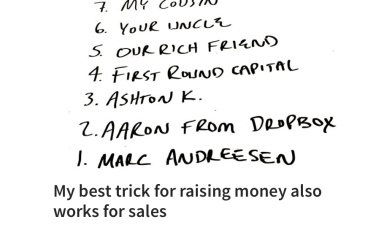
Publication number: ELQ-11389-1
View all versions & Certificate

How to Raise Money by Using the Reverse Investor List
Tips on how to raise funds by using the Reverse Investor List. This strategy can also be applied for sales pitches.
Introduction
I was a DJ in New York City for over a decade. I would sit home and work on my skills and I got really good. But there were three things I couldn’t practice in a bubble:
1) DJing is about energy—about playing off of the crowd—and that’s something I could only practice in real life.
2) I was alone when I was home spinning records, so it was easy to concentrate—but in the club there’s always someone talking to me (and they’re usually drunk).
3) There’s a lot more pressure when I have an audience.
So guess what? Even though I had practiced a lot, my first few live performances were…choppy.
I look at a lot of pitch decks. Some of them are great, and most of them need work. I go to a lot of investor meetings and I watch entrepreneurs trip over the same things that I did while DJing: They have to learn to play to the audience, people are always interrupting and asking unexpected questions, and there’s a lot more pressure.
- Step n°1 |
So what’s a founder to do?
Simple: figure out a way to practice on live audiences that don’t matter as much.
Here’s a strategy I call the Reverse Investor List (check out the video walkthrough attached to this post):
1) Start by rehearsing often. You don’t get to skip this step.
2) Next, make a list of all the potential investors you want to pitch. I like use a combination of my personal contacts, LinkedIn, and AngelList for this. Don’t worry if you don’t know each investor (I’ll write another article about getting personal introductions).
3) Prioritize the list. I like to use two factors: how much I want them to invest and how likely they are to invest.
4) Reverse sort the list, so that your least likely suspects are at the top.
5) Start pitching to your least likely suspects first.
Your first audiences will be tough because they won’t like your idea and they won’t want to invest. And that’s what you need at first. Let them watch you stumble over your words! Let them ask you the tough questions! Let them tell you why your business doesn’t have a chance of succeeding!
Then go back to your desk and update your pitch deck. Proactively answer the toughest questions in the first few slides. Take their suggestions to find a co-founder, or get some customers, or test your marketing, or whatever.
And then go pitch the next potential investor.
What happens is that you get better each time. It’s painful at first, but it gets easier. And if you’re working on your business at the same time you’re working on your pitch deck the whole thing becomes much more compelling. Your pitch gets stronger and stronger.
So by the time you get to your best and most likely investors you’re on fire. Your pitch deck is awesome, you know it cold, you’ve done the work to strengthen your business model, and you’re answering people’s questions before they even ask them.
And you get funded.

